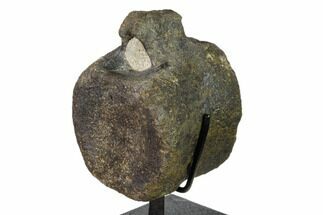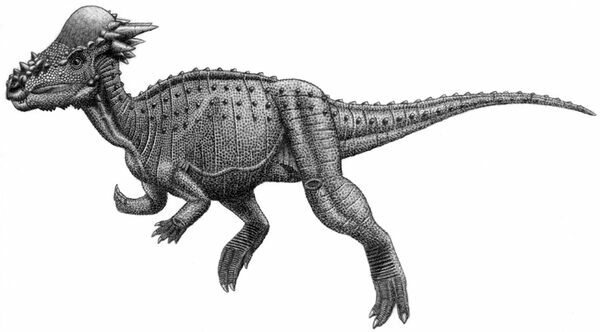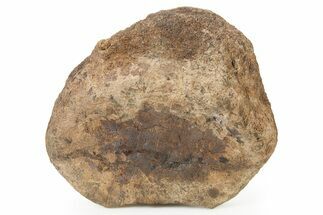This Specimen has been sold.
2.4" Dinosaur (Pachycephalosaurus?) Caudal Vertebra - Montana
This is a 2.4" long caudal vertebra centrum of a dinosaur (Pachycephalosaurus?), collected from the Late Cretaceous Hell Creek Formation in Fallon County, Montana. There are areas of the bone where fragments have chipped away. These spots have been stabilized with glue to prevent further chipping.
Isolated vertebra from Thescelosaurus and Pachycephalosaurus can be difficult to distinguish between, however the rounded horizontal ridge along the sides of the vertebra indicate this could be from Pachycephalosaurus.
Isolated vertebra from Thescelosaurus and Pachycephalosaurus can be difficult to distinguish between, however the rounded horizontal ridge along the sides of the vertebra indicate this could be from Pachycephalosaurus.
Pachycephalosaurus was a medium-sized herbivorous bipedal dinosaur from the Late Cretaceous in North America, most notably in the Hell Creek Formation. Pachycephalosaurus is a genus that has had much controversy taxonomically. The two contemporaneous genera Stygimoloch and Dracorex have undergone much scrutiny to determine whether they are valid species or if they are actually juvenile growth stages of Pachycephalosaurus. Most current consensus suggests that they are, making Pachycephalosaurus the predominant Pachycephalosaur of the Hell Creek Formation.
Pachycephalosaurus was a bipedal dinosaur that lived during the Late Cretaceous period and probably was about 15 feet in length.
Pachycephalosaurus had a distinctive large, bony dome on top of its skull up to 10 inches thick to cushion its brain from impacts.
Some paleontologists believe this thick skull may have been used for head-butting, much like modern rams, while others contend it may have been a sexual display.
It was one of the last non-avian dinosaurs before the K-T extinction event, 65 million years ago.
There is only one known species of Pachycephalosaurus, Pachycephalosaurus wyomingensis. Its remains have been found in Montana, South Dakota, and Wyoming.
It was either an herbivore or omnivore with small leaf-shaped teeth effective for shredding plants.
Because of its age and sedimentary composition, the Hell Creek Formation has become one of the most paleontologically studied areas in the world. 158 genera of animals and 64 genera of plants are known from the formation and new discoveries are made frequently. In addition to Tyrannosaurs, Ceratopsids, and Hadrosaurs, the formation has yielded remains of amphibians, reptiles, lizards, snakes and turtles, fish and sharks, avian and non-avian dinosaurs, and mammals. The Hell Creek Formation gives the most complete understanding of the environment just before the Cretaceous-Paleogene extinction.
SPECIES
Pachycephalosaurus sp.?
LOCATION
Fallon County, Montana
FORMATION
Hell Creek Formation
SIZE
2.4 x 1.75 x 1.7"
CATEGORY
SUB CATEGORY
ITEM
#245864
We guarantee the authenticity of all of our specimens.
 Reviews
Reviews















